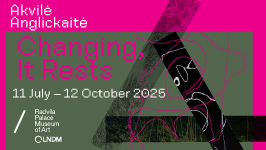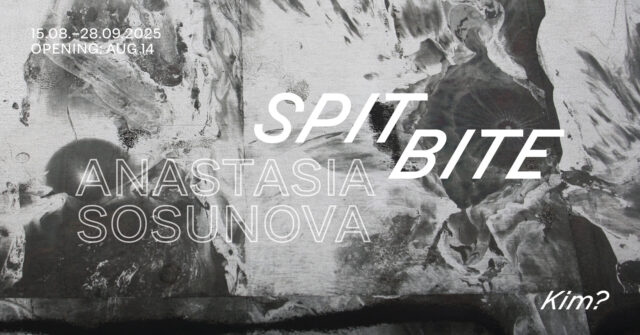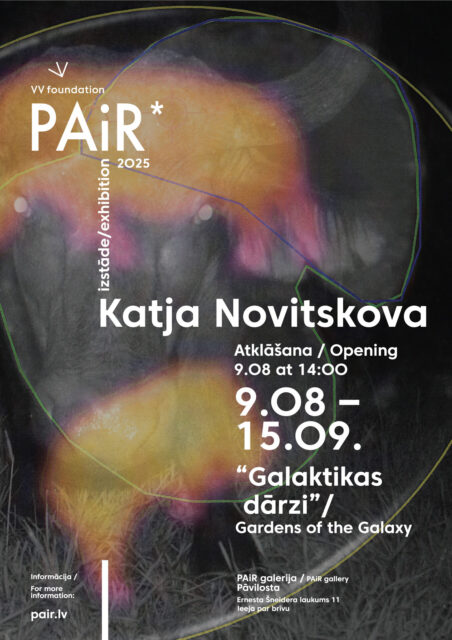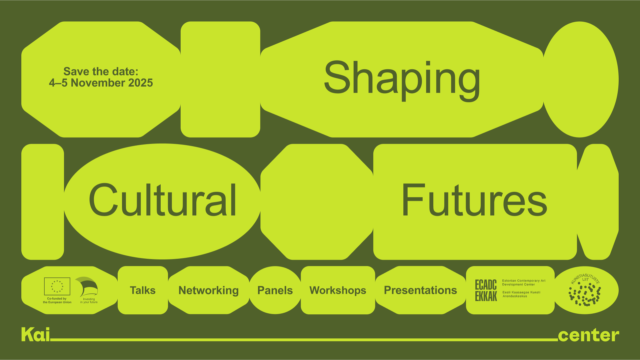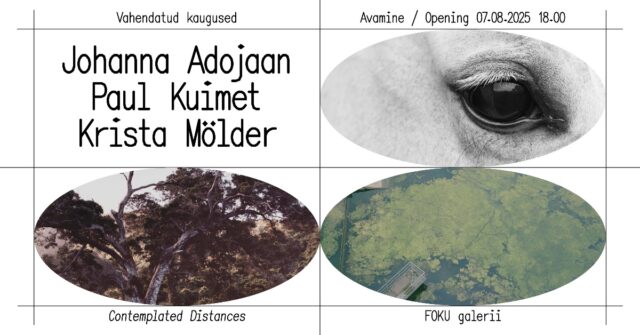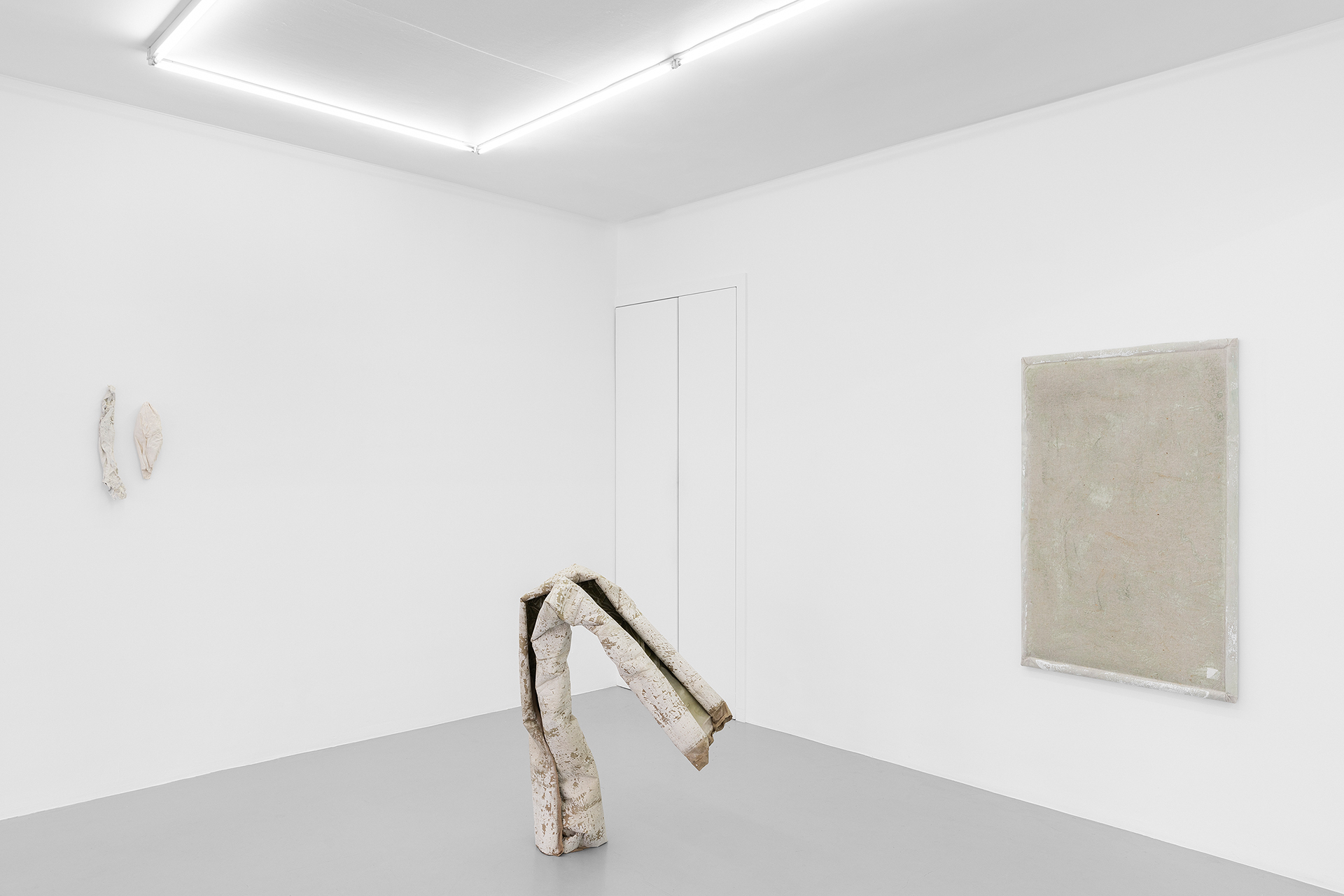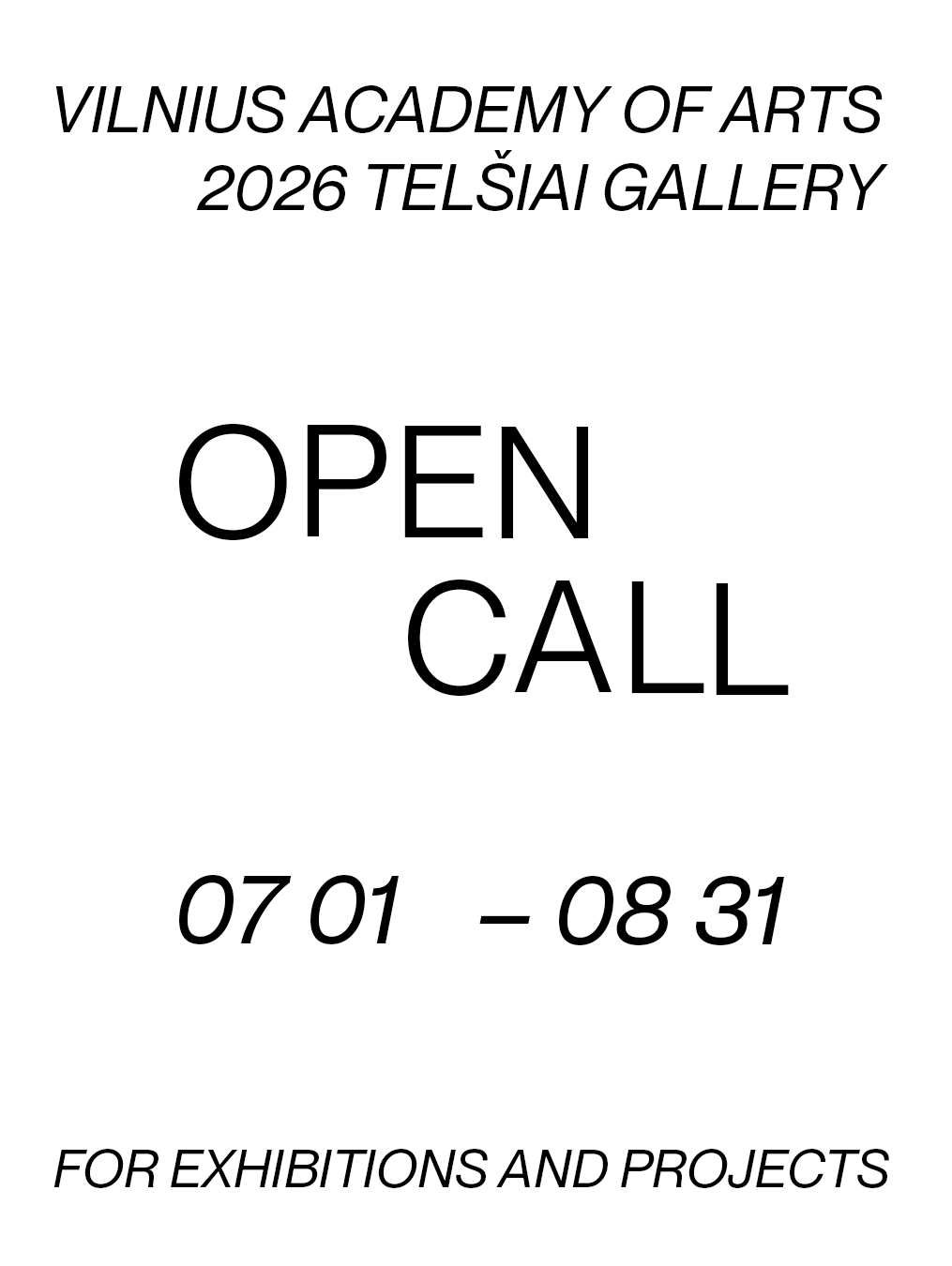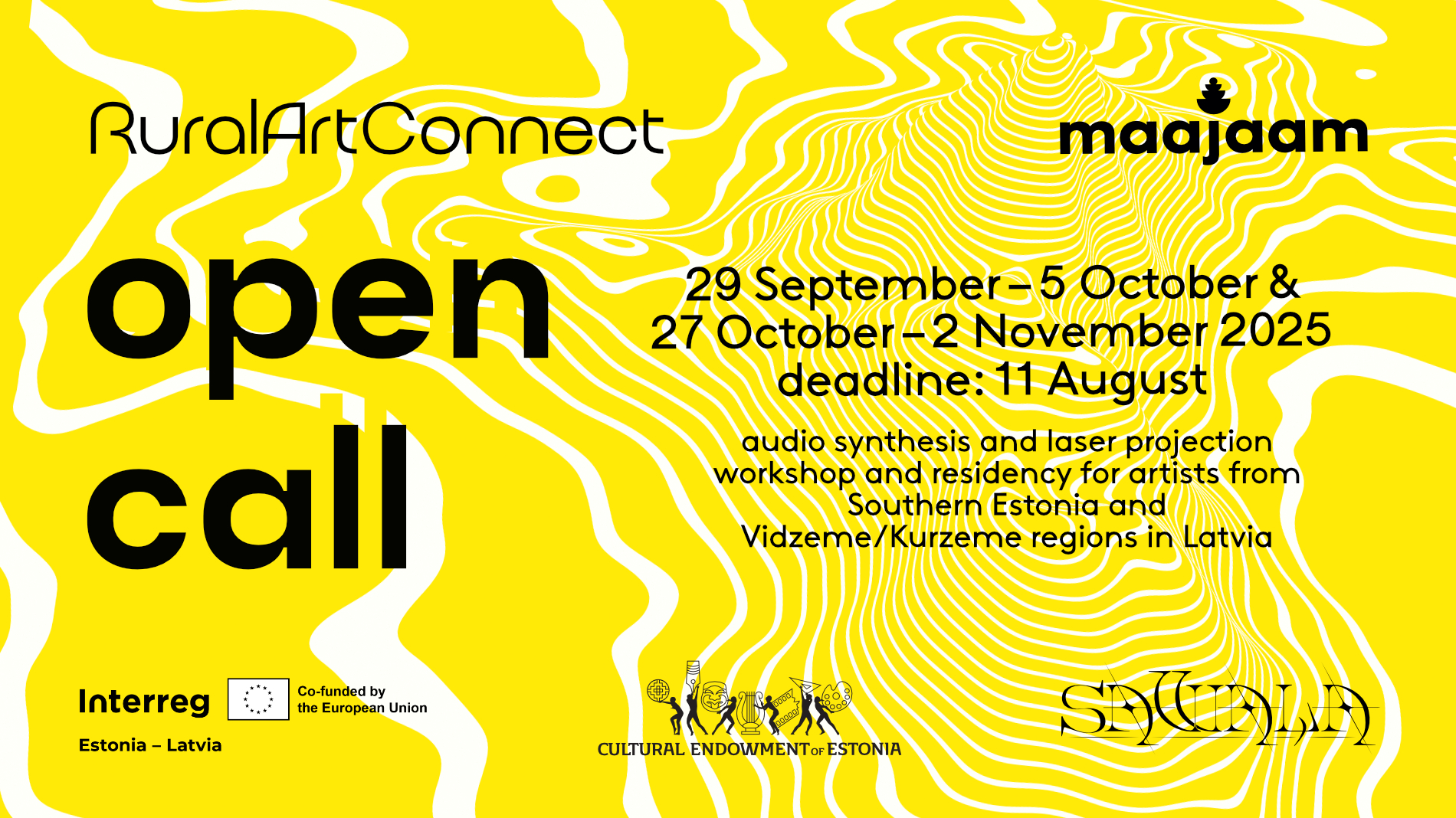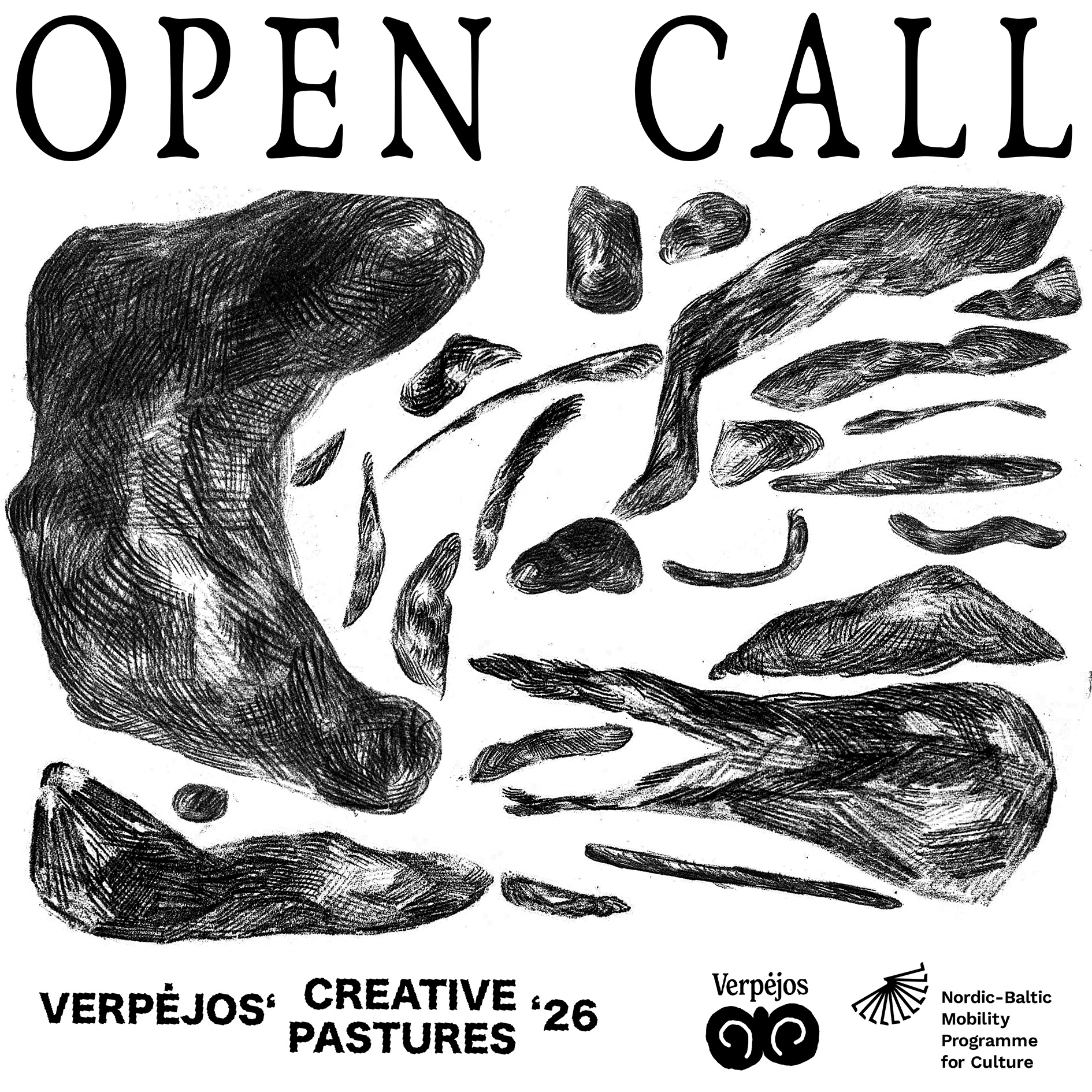There is a deep structural quandary in contemporary art. What was once primarily a public funding phenomenon crossed over to the private sphere: the funding mechanisms that underwrite much of artists’ work demand easily quantifiable social relevance and demonstrable scholarly research.
This paradox is not inherently harmful. There are numerous outstanding projects platformed through these opportunities. Yet we must acknowledge its consequences for all those associated with it—museums, curators, artists and audiences.
I remember a long conversation with Gediminas several years ago in Venice. We walked across the city for around an hour, heading towards one party or another. While Gediminas and I did most of the talking, Nomeda interjected from time to time with a well-placed note or historical correction. We debated the relationship between art and architecture, the responsibilities of artists to the environment, and the gap between the display of contemporary art and the effectiveness of its core message.
Together, Nomeda and Gediminas Urbonas—the Urbonas Studio—are incredibly charming, well-read and motivated. Their personalities encourage you to join their movement, their decades-long endeavour of using the frameworks of architecture and art to impel humanity towards correcting its fundamentally extractive relationship with the environment, using the theme of swampland.
‘Partially Swamped Institution’ is a mid-career survey of the Urbonas Studio’s extensive production and research. Curated by Lars Bang Larsen for Lithuania’s National Gallery of Art, the exhibition is full of content, with a promising introduction proudly emphasising its purpose and urgency.
Apart from this exhibition, the National Gallery’s main level is very bare this summer. It is not unique to the show, but the spartan atmosphere of the museum does not exactly welcome visitors.
After passing several empty spaces and stairwells, the introductory text and banners appear. Across from this, there is a landscape intervention in the courtyard, a model swamp, transplanted from a location in another region of the country. This ‘swamp exchange’, described deep inside the introductory text, promises to be the most contextually relevant and active part of the exhibition. The description further alludes to a series of offsite events at the place where the swamp-on-loan originated, without much additional detail. I must admit, when first reading about the show, I presumed that they might install a large semi-permanent swamp ecosystem in or around the museum: exciting! This action, however, appeared secondary to the collection of works in the main gallery.

‘Partially Swamped Institution’ by Nomeda and Gediminas Urbonasat at the National Gallery of Art, 2023. Photo: Gintarė Grigėnaitė
There is no wayfinding or connective tissue between the show’s introduction, the courtyard, and the rest of the exhibition. Eventually, to the right on departing through the courtyard door, a narrow aperture opens up looking over the main gallery in the basement.
The overhead view reminds me of architecture expos or biennials where the forms appear closer to contemporary sculpture or installation, and heighten their assumed significance. An immediate reference was Bruce Mau’s ‘Massive Change’ at MCA Chicago in 2006. I visited that show as a raw, somewhat naïve, art student, following my initial pursuits in architecture. Mau’s work was not as critical in content—he frames his work primarily as design rather than art—nor was it perhaps even as good as ‘Partially Swamped Institution’. Still, I recall it as a more compelling exhibition, thanks to its communication and curation.
‘Massive Change’ cultivated a narrative. There were causes, effects, and potential responses for viewers to consider. Mau proposed concrete actions to his audience that they could relate to and act on. He displayed a plurality of ideas for mobility, housing and social economics. Yes, it was less of a fine art spectacle, but it paid so much attention to the language used. It made climate and environmental activism a relatable, universal concern, not one isolated in the confines of intellectualism, visual art and high culture. Mau recognised the opportunity and the responsibility of his platform.
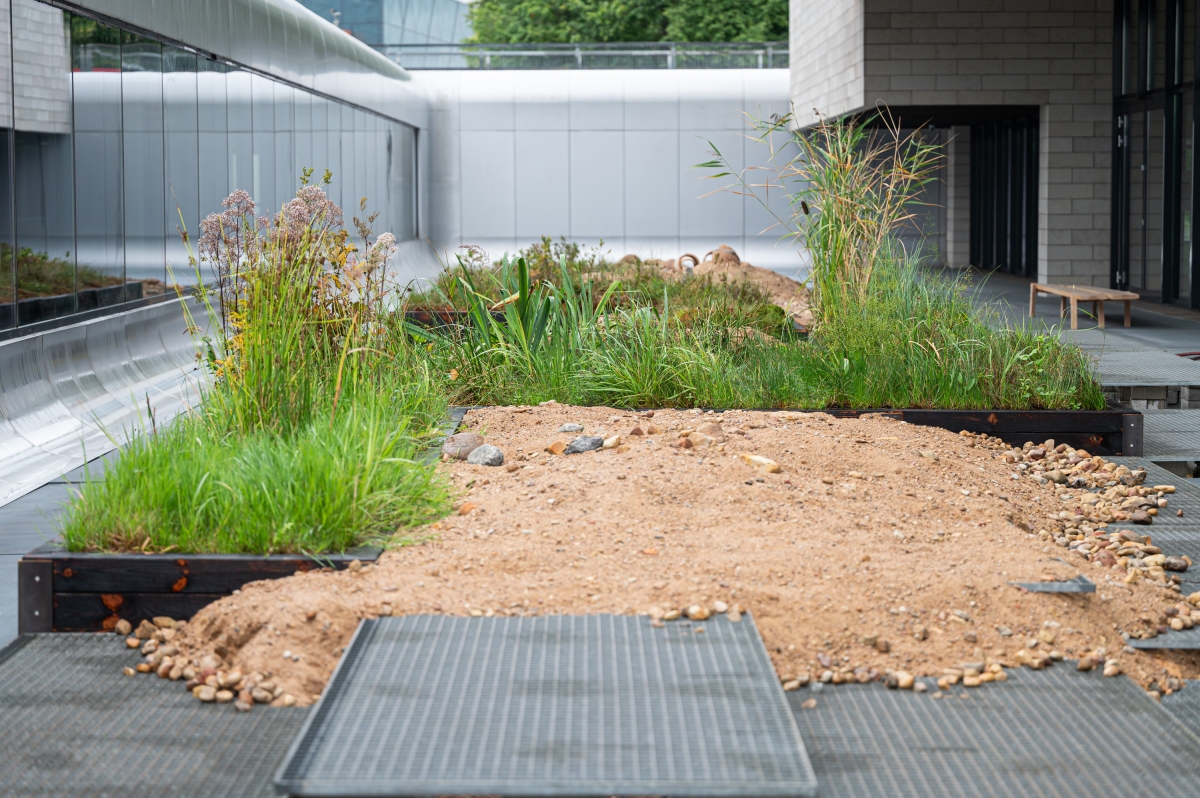
‘Partially Swamped Institution’ by Nomeda and Gediminas Urbonasat at the National Gallery of Art, 2023. Photo: Gintarė Grigėnaitė
‘Partially Swamped Institution’ conveys a pretence of similar accessibility and inventiveness. The Urbonases highlight intriguing futures in several projects, but the exhibition format muddies their potential to affect the world outside the museum.
Back on the balcony, beside the view over the Urbonas’ exhibition, hides a micro-intervention, a wall crevice revealing a tiny grotto with an out-of-focus video. Entitled Swamp Intelligence (2018-2020), this is the most playful and joyous part of the exhibition, an attempt to be magical and unexpected. It is a miniature geological diorama, containing a Paul Pfeiffer-esque projection of colourful and blurry computer-generated imagery. It is so slight, the work would be easy to miss. The staircase, just beyond, leads you down to the basement gallery floor.
At the bottom lie two casual piles of stapled papers, one Lithuanian and one English. These are your only compass to the morass before you. Each body of work gets one or two pages, with expository texts similar to academic abstracts, complete with studious lists of collaborators and citations. I gleaned most of the detail from this document rather than the presentation itself. For example, a description of the Swamp Intelligence wall video, which you might encounter first, is buried on page 21.
The lack of exhibition guidance makes it quite a challenge to assess what is going on. I moved anti-clockwise around the gallery, after some effort to parse the order of the works in the packet. The only other details were work titles on the outer wall, not always near to what they reference. The installation of the projects also bleed into the others, so discerning what elements belong to each one is less than intuitive.
First on the right came River Runs (2012), a study of river usage around Oxford in the UK, and an associated proposition from the Urbonas Studio. A series of episodic interviews with people living and working on the river play on a wood-mounted video wall. Opposite that, there is a large projection of Jellyfish Lily in action. It is a prototype watercraft, launched from a mobile pier system that the Urbonases pilot. Each neoprene lily pad carries a person who, on entering, sinks into the river in suspended stasis with the water. The pad detaches from the pier, and the person goes adrift without much control of their direction, unable to exit without assistance. It is an intriguing concept as a live experience: the text proclaims it as wearable technology, although I believe that stretches the term.
Out of all the projects, this reads as the most actionable. What it proposes, a new public space composed of synthetic fabric to hedge against rising sea levels and bring humankind closer to the Earth’s finite resources, is not especially compelling. I support the project’s intentions, but it is unclear why this proposition makes a significant impact in addressing the fundamental issues its research reveals: acknowledging the planet’s changing topography, and creating new sites for collective urbanism. Nor is it clear conceptually why the materials and methods the Urbonases chose are appropriate for the job. Is neoprene only a first draft of their concept, until biotechnology catches up?
Proceeding further, there are unmarked tanks of microorganisms, printed tapestries of pop-cultural swamp references mixed with research data, and stacks of visual documentation on transparencies sitting in messy stacks next to overhead projectors. These projector stacks recur in other locations in the gallery. I suppose the intention is for audiences to change the sheets and explore the archive. If so, this is opaque. I did not feel encouraged to do so.
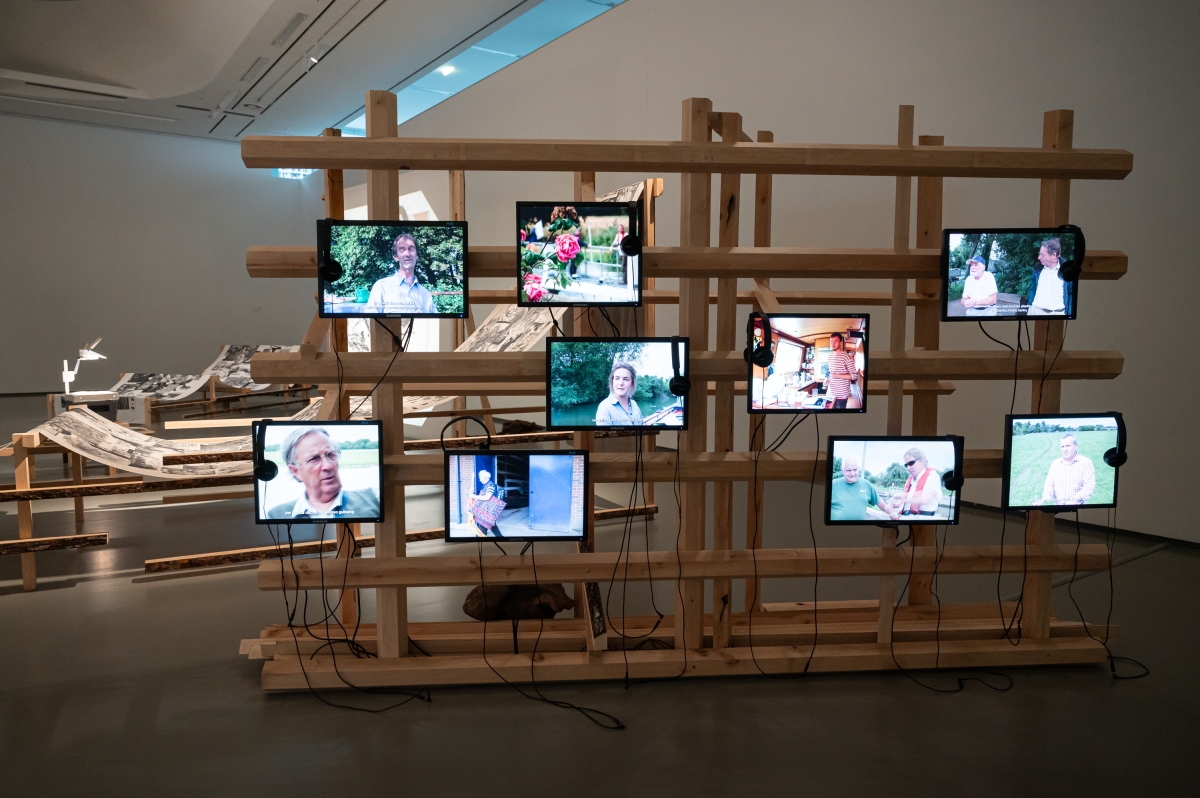
‘Partially Swamped Institution’ by Nomeda and Gediminas Urbonasat at the National Gallery of Art, 2023. Photo: Gintarė Grigėnaitė

‘Partially Swamped Institution’ by Nomeda and Gediminas Urbonasat at the National Gallery of Art, 2023. Photo: Gintarė Grigėnaitė
I have an above-average spatial sensibility. At this point, although the show looked logical from a bird’s-eye view, I was disoriented. Where is the direction? Why are there chasms between the upstairs elements, only to cram the main gallery?
A large lightbox wall further on is dedicated to Mushroom Power Plant (2017-2021), an extended study of bioenergy generation using mycelial networks to process common minerals. The graphics are beautiful, and the idea is huge. In line with current trends, it reimagines fungal metabolism as an enormous, extant battery and power management system. Although pretty, the visuals on their own do not tell me much. I feel it could have occupied much more of the overall content. It is a great concept, but I would not comprehend the artist’s intentions and scope without the accompanying text.
Next to this is Swamp Observatory (2020), a multi-part paean to the significance of peat bogs in balancing carbon and supporting life throughout the planet. There is a hanging peat structure, a floor-bound one, a stack, and graphic projections. One suggests an olfactory experience (they all seem to smell), and the rest serve other representative functions. It looks clever, and the exhibition packet details a lot. Iit still comes across as repetitive and messy. The significance of peat to sustainability is not heightened by the formal choices. The work claims to bear witness to natural processes outside human intervention. Nonetheless, one peat bog was shaped into a mammalian lung. Another bog sculpture was composed of perfect cuboids.
There is a well-documented history of ravaged peatlands in the Scottish countryside in the 1980s, funded by affluent entrepreneurs and celebrities. Companies planted forests of new, non-native tree species, both as a self-congratulating act of climate protection and a tax benefit mechanism. That debatably well-meaning action released aeons of stored carbon. Those same peatlands are undergoing costly, arduous restoration to undo even part of the ecological disaster caused by humankind’s condition of pointing to the environment to feel better about themselves. The Urbonas Studio project claims to celebrate bogs, but also poses the question—what does it accomplish for the bog? Excavating peat from its origin is a violent act and disrupts much of its benefit. There is plenty left unsaid on the consequence of moving these lands to the gallery.
A strong contrast exists between this project and the Power Plant. Swamp Observatory spectacularly celebrates and acts as an ambassador for the bog, incorporating a huge amount of content, without a clear benefit to the bog. Mushroom Power Plant has the genesis of genius for the whole of the terrestrial biosphere. However, there is little else to absorb other than the artistic equivalent of a development pitch deck.
Eat Me (2020), an interactive video game, occupies the adjacent corner. There are controllers and a large vertical screen. The visual style is reminiscent of early 3D graphics from the 1980s and 1990s. You occupy a species’ point of view, with wireframe clusters of unfilled polygons representing other species that might consume you. There are no instructions. Manipulating the buttons and the directional pad did not give me much sense of control. After experimenting for a while, I was apparently eaten enough times to be congratulated on my progress. I moved on.
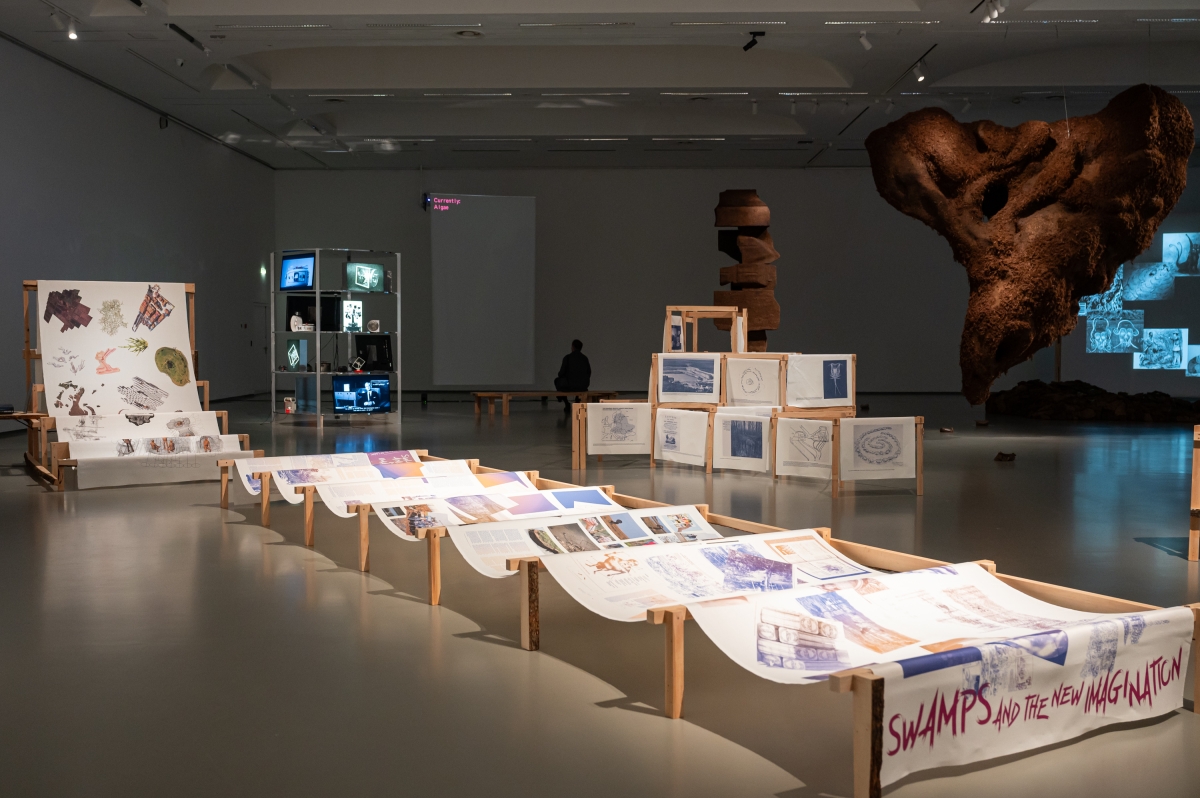
‘Partially Swamped Institution’ by Nomeda and Gediminas Urbonasat at the National Gallery of Art, 2023. Photo: Gintarė Grigėnaitė
On the floor around the hanging peat lung is a scattered series of QR code sculptures making up Eco-Monsters (2019-2022). Each code presents an interaction with a fictional non-human life form using augmented reality transmitted through your smartphone screen. The characters, rendered on your phone, are fun. They appear to move, breathe and dance in the gallery, although the QR codes summon creatures one at a time, sequentially rather than simultaneously. The eco-monsters do not interact with one another as a ‘shadow biosphere’, as the text suggests. It is a technically astute work that does not add much to the overall content.
Where the potential of other projects lies with science, the film installation TRANSmutation (2018-2020) might be the most promising artwork in the whole exhibition. Using an espionage thriller’s cinematic form, with elements of space botany and interspecies science fiction, it presents provocative and unresolved questions. It is shown on multiple screens in a gleaming tower that references orbital architecture, urban futurism, and industrial design. There are clips of what appear to be mid-century Eastern European spy thrillers, slick computer-generated product shots of scientific equipment, and a menacing voiceover. This project is another segment of the show deserving much more focus and spatial attention, as opposed to the multiple bogs and schoolroom overhead projectors.
The show’s tone leans techno-positive, believing in experimentation and innovation as a conceptual tool to reassemble a symbiosis between humans and the complex, living planet our species inhabits. It is likewise dystopic, in that the Urbonas’ research signals predestination: humanity is bound to be overtaken by the advancing swamp. Or, it already has been.
The spectacular scenography and staging in the main gallery also confuse the individual elements. It professes engagement, without offering much. The separation of the courtyard, the introductory text, and the main body of the show do not favour the visitor. There is an evident lack of curatorial consideration for guests to know the flow of the exhibition, which elements of the show to interact with, and how. The QR codes, for example, assume you have a smartphone. Once scanned, the OS prompts you to download an unknown app. I would prefer a notice about this requirement before entering. The stacks of transparencies appear engaging, open and interpretative. Yet I did not see anyone else attending the show on two separate days—apart from myself—changing the sheets and exploring those piles of data.
What is the curatorial intent of this survey? There is much consideration here for the communication of research-based art. What role does the National Gallery play? Is their only duty writing the hagiographies of contemporary Lithuanian artists? Are they solely walls and a floor, to host whatever content occurs there? Very little was taking place in the museum, apart from the collection upstairs, making the sparse presentation more baffling. Here was an opportunity to make an enduring impact, a statement about why this type of work can reach beyond the connoisseurs, something a state-run museum is well placed to support and enact.
The exhibition’s title suggests at least a partial swamping of the institution. I am confident that there is no swamp to be found, aside from the bureaucratic one. A swamping of this museum, in the best case, can only be a partial one. There is no consequence to this project for the National Gallery, no real commitment to sustain the swamps or put funding towards their protection and proliferation. It is just another visual art exhibition, followed by similar programming in perpetuity.
The National Gallery is on the bank of the River Neris—a former swampland—and bizarrely seems to ignore its immediate environment in favour of distant references. The exhibition texts suggest institutions of the future as political subjects, like ecosystems. The presentation does very little to reinforce this assertion. The model courtyard swamp garden is only borrowed. What will remain?
‘Partially Swamped Institution’ includes fascinating, relevant subjects, from accomplished artists at a high level. It requires a deeper engagement than the visual experience. I am convinced the Urbonases understand that and desire their work to represent more. They surely proposed the courtyard swamp to animate the exhibition and avoid it becoming a pure retrospective. Something blocked it from being better.
When a display of intelligent art lacks cohesion, with the scale of the presentation as a force multiplier, I have questions. The problem here is foundational. A neutralised white cube exhibition for such an urgent crisis is an anachronism. Why isn’t the National Gallery using this opportunity to lead the fight, rather than hang the Urbonas’ banner as a hollow virtue signal of solidarity?
What is the audience called to do by this exhibition? It feels independent of viewership, cold to your understanding or approval, while donning a veneer of urgency. What do we do with this information? Are we only asked to think philosophically about the blurred lines between nature and culture, art and science? Are we meant to admire the breadth and depth of yield from the Urbonases? What encourages us to go out into the world and do likewise?
The ‘swampiness’ of the scenario could be a calculated choice, a symbiosis with the content. If this were the intention, what end does it serve? Swamp for swamp’s sake?
The exhibition boasts the support of a long list of contributing partners, as do most large-scale institutional projects. Contemporary art funding mechanisms, built on the foundation of seasonal applications that only afford short-sighted surface-level results, are completely inadequate to address the environmental or social topics they purport to serve. Change is unquantifiable in a single budget cycle. Systemic and ecosystemic shifts take decades.
Yes, these financial constraints apply to all arts professionals. There remained an opportunity with this exhibition to show the way forward. Compared to other countries, an institution like the National Gallery can potentially foster a collective will in national arts administration to carve a new path for topical projects that reach further than the next six months. Most institutions still default to localised imitations of what is accepted elsewhere.

‘Partially Swamped Institution’ by Nomeda and Gediminas Urbonasat at the National Gallery of Art, 2023. Photo: Gintarė Grigėnaitė
Culpability lies with the institution which appears ambivalent to the intention and the topic of the show, and perhaps the curator, who seems to have ignored the fact that most visitors will not have a background with the artists. I can only surmise that the museum does not care about the subjects of their exhibitions or the public’s understanding of them.
Museums can no longer afford neutrality. They are as accountable as any other public entity, and have a responsibility to their audiences. They are not theme parks for citizens to ride rollercoasters of history, politics and culture. They are the armouries and treasuries with which to do battle.
Still, I can only read the show as it is, rather than project what could have been.
The Urbonases are professional educators, talented and experienced. Their multi-decade career hinges on communicating exciting ideas to motivate students to learn more. These artists bear an important message and an impressive body of enacted research. The list of contributors to the project is long and impressive. The venue is as high-profile as the country can offer.
The disappointing presentation and contextualisation blunt the impact of the Urbonas Studio’s aggregated practice. Why must this ostensible swamp of accomplishments stand so stagnant and lifeless?




